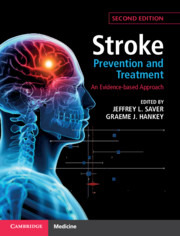Book contents
- Stroke Prevention and Treatment
- Stroke Prevention and Treatment
- Copyright page
- Dedication
- Contents
- Contributors
- Preface
- Part I Foundations
- Part II Systems of Care
- Part III Acute Treatment of Ischaemic Stroke and Transient Ischaemic Attack
- Part IV Acute Treatment of Haemorrhagic Stroke
- Part V Prevention
- Chapter 15 Prevention of Stroke by Lowering Blood Pressure
- Chapter 16 Prevention of Stroke by Lowering Blood Cholesterol Concentrations
- Chapter 17 Prevention of Stroke by Modification of Additional Vascular and Lifestyle Risk Factors
- Chapter 18 Drugs, Devices, and Procedural Therapies to Prevent Recurrent Cardiogenic Embolic Stroke
- Chapter 19 Long-term Antithrombotic Therapy for Large and Small Artery Occlusive Disease
- Chapter 20 Carotid and Vertebral Artery Revascularization
- Chapter 21 Cervical Artery Dissection and Cerebral Vasculitis
- Chapter 22 Prevention of Intracerebral and Subarachnoid Haemorrhage
- Part VI Stroke Rehabilitation and Recovery
- Index
- References
Chapter 22 - Prevention of Intracerebral and Subarachnoid Haemorrhage
from Part V - Prevention
Published online by Cambridge University Press: 15 December 2020
- Stroke Prevention and Treatment
- Stroke Prevention and Treatment
- Copyright page
- Dedication
- Contents
- Contributors
- Preface
- Part I Foundations
- Part II Systems of Care
- Part III Acute Treatment of Ischaemic Stroke and Transient Ischaemic Attack
- Part IV Acute Treatment of Haemorrhagic Stroke
- Part V Prevention
- Chapter 15 Prevention of Stroke by Lowering Blood Pressure
- Chapter 16 Prevention of Stroke by Lowering Blood Cholesterol Concentrations
- Chapter 17 Prevention of Stroke by Modification of Additional Vascular and Lifestyle Risk Factors
- Chapter 18 Drugs, Devices, and Procedural Therapies to Prevent Recurrent Cardiogenic Embolic Stroke
- Chapter 19 Long-term Antithrombotic Therapy for Large and Small Artery Occlusive Disease
- Chapter 20 Carotid and Vertebral Artery Revascularization
- Chapter 21 Cervical Artery Dissection and Cerebral Vasculitis
- Chapter 22 Prevention of Intracerebral and Subarachnoid Haemorrhage
- Part VI Stroke Rehabilitation and Recovery
- Index
- References
Summary
Intracerebral haemorrhage and subarachnoid haemorrhage are associated with considerable morbidity and mortality. Too often the focus is on acute treatment after a haemorrhage has occurred, instead of primary and secondary prevention. Medical therapies to control hypertension, achieve tobacco abstinence, and avoid excessive alcohol consumption can confer broad reductions in haemorrhage risk across pathophysiological subtypes. Judicious restriction of antiplatelet and anticoagulant therapies to only those individuals and those intensities for which they are indicated also can substantially reduce haemorrhagic stroke frequency. Specific endovascular and surgical therapies, judiciously employed, will further reduce risk of first or recurrent haemorrhage from structural vascular anomalies, including arteriovenous malformation, cavernous malformations, and saccular aneurysms. For unruptured intracranial aneurysms, features that favour consideration of preventive occlusion include include younger patient age, prior subarachnoid haemorrhage from a different aneurysm, familial intracranial aneurysms, large aneurysm size, irregular shape, basilar or vertebral artery location, and aneurysm growth on serial imaging. Among individuals who are technical candidates for either coiling or clipping, endovascular coiling is associated with a reduction in procedural morbidity and mortality but has a higher risk of recurrence.
Keywords
- Type
- Chapter
- Information
- Stroke Prevention and TreatmentAn Evidence-based Approach, pp. 463 - 484Publisher: Cambridge University PressPrint publication year: 2020

